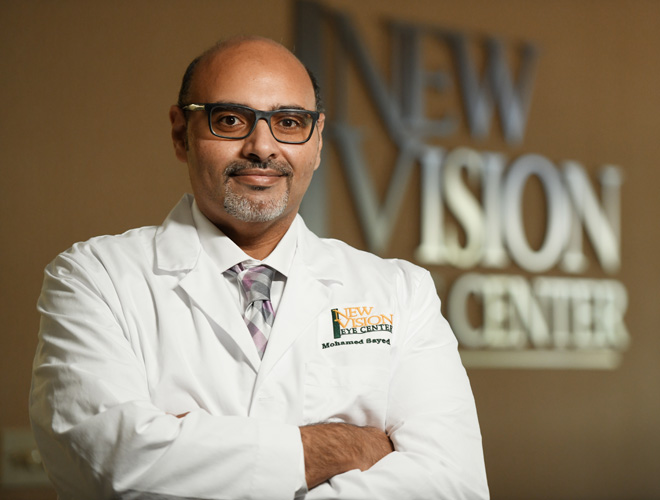
Vero Beach’s New Vision Eye Center just added a new member to its ophthalmology team, Dr. Mohamed Sayed.
With fellowship certifications from both the Royal College of Surgeons of the United Kingdom as well as the U.K.’s International Council of Ophthalmology, Sayed brings an advanced skill set to Vero, offering what he calls “the most advanced anterior segment surgery; glaucoma treatments including laser treatments; minimally invasive glaucoma surgeries; and cataract surgeries with premium lens implants.”
That’s a major plus because glaucoma and cataract cases are common here – especially glaucoma cases.
In the simplest of terms, glaucoma is a group of eye disorders that leads to progressive damage of the optic nerve which can cause irreversible blindness.
According to the American Academy of Ophthalmology, there are two main types of glaucoma.
In the most common form of primary open-angle glaucoma, the eye doesn’t drain fluid as well as it should and as a result, eye pressure starts to build and damage the optic nerve. In angle-closure glaucoma, the narrow-angle between the iris and cornea causes blocked drainage canals which can result in rapid eye pressure. If not treated right away, angle-closure glaucoma can cause blindness.
Worse, as the Mayo Clinic points out, “the damage caused by glaucoma cannot be reversed.”
Unfortunately, according to the University of Michigan’s Kellogg Eye Center, most people don’t even know they have glaucoma unless they have regular eye exams, which is why the disease remains a leading cause of blindness worldwide.
The Kellogg Center continues, “early detection and treatment by an ophthalmologist are the keys to preventing optic nerve damage and vision loss from glaucoma,” and Dr. Sayed agrees.
“Glaucoma, in its most common form, is unfortunately a disease that has no symptoms, which means patients can lose considerable vision without even noticing,” according to Sayed.
“Since, typically, the peripheral vision is lost in early glaucoma, the patient may maintain excellent central vision until the disease has irreversibly wiped out the entire peripheral vision before central vision is finally lost in end-stage disease.”
Some other types of glaucoma, Sayed adds, may have other symptoms.
“For example,” he continues, “in a less common type of glaucoma called angle closure glaucoma, patients may have intermittent episodes of eye pain, headache, blurred vision and halos around light.
“In the acute form of that disease,” Sayed continues, “patients may experience intractable pain, loss of vision and vomiting, and [then] emergency treatment is typically necessary.”
That is why, according to Sayed, “as a general rule, all individuals who are 40 or above should have an annual eye exam. For those with a family history of glaucoma, particularly in first-degree relatives, they should seek expert help to rule out glaucoma at an even younger age.”
And, almost unique among his peers, Sayed is equipped to deal with those younger patients, too.
He also has a fellowship certification in pediatric ophthalmology from Miami’s Bascom Palmer Eye Institute, where he was also an assistant professor of ophthalmology.
That kind of academic achievement could lead to cockiness.
Sayed, however, takes a modest approach, saying many of his peers are capable to handling this disease because “recent advances and innovations in the field have rendered glaucoma care – including cutting-edge imaging studies and treatment modalities – something most ophthalmologists and cataract surgeons are competent at providing, particularly in milder forms of the disease.”
When pressed, however, he admits “there are types of complex glaucomas associated with other ocular and systemic disorders that are more resistant to standard treatments [and] in these instances, the intervention of a glaucoma specialist is typically necessary.”
As the new kid on New Vision’s block, Sayed joined the team of Drs. Minotty, Tate, O’Brien and Reinauer on June 6.
“Glaucoma,” he says, “is primarily an age-related condition that affects mostly older individuals who commonly have family history of the disease. However, it can affect pretty much any age group.
“In fact, children can even be born with it. Additionally, children may also suffer from cataracts. Part of our job [at New Vision] is educating our colleagues in other specialties such as obstetricians and pediatricians on possible signs that can be recognized in a newborn or a child with possible glaucoma, cataract, or other ocular disorders so that referral to expert ophthalmic care is done in a timely manner.”
Dr. Mohamed Sayed is now seeing patients at Vero Beach’s New Vision Eye Center at 1055 37th Place. The phone number is 772-257-8700.



